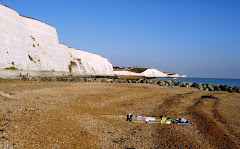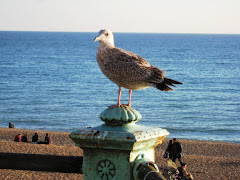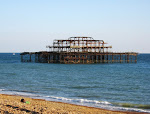
After the washout summer we've had, it's quite a relief to get some cool, dry weather for autumn.
Autumn - or fall as our Transatlantic cousins call it - has been consistently voted America's favourite season for many years. If you've ever been to New England, you can understand why: nature's famous display of autumn colour there really is something to behold. But there's something equally captivating about autumn in Britain. We may not have quite the brilliant reds and golds, but it's still beautiful, and after the excesses of summer it can be quite nice to have some cooler, breezier weather, and begin to look forward to cosy winter evenings by the fire.
It's undoubtedly my favourite season. And I'm in good company - the poet John Donne famously wrote, "No spring nor summer beauty hath such grace, as I have seen in one autumnal face".
For children, a potent memory is kicking autumn leaves on the pavement or footpath, and for me the thrill has never entirely disappeared - I sometimes find myself, when there's no-one looking, kicking a big pile of fallen leaves just for the fun of it! However, a recent CBBC poll found an overwhelming majority of British children choosing summer as their favourite season, although the reasons given - no school and the prospect of summer holidays - provide a fairly predictable analysis!
But for me, autumn brings another added bounty: mushroom hunting. Now, this really is something we Brits are shy about. We seem to have a primeval fear of toadstools, being all too aware of the potentially deadly consequences of eating poisonous ones. Now, I have to confess here that I studied fungi as part of my PhD and am a member of the British Mycological Society. But even so, I'm not actually that great an expert when it comes to identifying wild fungi in the field - more a case of knowing when to admit that I can't identify it, and erring on the side of caution.
But some of the most poisonous fungi are easy to identify if you know what you are looking for, as are some of the best: the great Giant Puffballs (Calvatia gigantea), when young and fresh, are astonishing to look at and just as astonishing to eat: the size of a football, with a creamy interior resembling a fragrant, savoury marshmallow, they can be cut into slices and fried like steaks to great effect. Or some giant Parasol Mushrooms (Macrolepiota procera) - again with caps the size of dinner plates - have been simply delicious.
My best ever experience - although some find it a indigestible - was a cache of the wonderfully named 'Chicken of the Woods', Laetiporus sulphureus (sometimes known as the Sulphur Polypore). This vivid, almost fluorescent yellow and golden bracket fungus, is found on living broadleaved trees, and the younger and fresher golden part has a wonderful, rich taste, not entirely unlike chicken, and perfect for casseroles. It's a delicacy in parts of central Europe, and Germany especially, where they are more accustomed to gathering fungi. Even in Catalonia, the part of Spain I know best, the markets are full of brightly coloured fungi, and frozen and tinned versions are available for those who prefer easy preparation.
For those thinking about going mushroom hunting and with no experience, the best place to start is the website of the Association of British Fungus Groups. There, you can find a local group and join a fungal foray with experts who know what they doing. They will also advise you on which field guides to buy, and learn the ropes of identifying some of the commoner fungi, as well as which to steer clear of. You can even go on a residential course to learn more. They will also advise on conservation: as with all aspects of nature on our islands, this is an increasingly important issue (the rule of thumb is always to leave a proportion of what you've found to provide the next generation).
Even if you don't care to eat them - and many are not edible anyway - it can greatly increase your enjoyment of autumn walks in parks and the countryside when you see a little clutch of fungi, and many are great to photograph!
Autumn - or fall as our Transatlantic cousins call it - has been consistently voted America's favourite season for many years. If you've ever been to New England, you can understand why: nature's famous display of autumn colour there really is something to behold. But there's something equally captivating about autumn in Britain. We may not have quite the brilliant reds and golds, but it's still beautiful, and after the excesses of summer it can be quite nice to have some cooler, breezier weather, and begin to look forward to cosy winter evenings by the fire.
It's undoubtedly my favourite season. And I'm in good company - the poet John Donne famously wrote, "No spring nor summer beauty hath such grace, as I have seen in one autumnal face".
For children, a potent memory is kicking autumn leaves on the pavement or footpath, and for me the thrill has never entirely disappeared - I sometimes find myself, when there's no-one looking, kicking a big pile of fallen leaves just for the fun of it! However, a recent CBBC poll found an overwhelming majority of British children choosing summer as their favourite season, although the reasons given - no school and the prospect of summer holidays - provide a fairly predictable analysis!
But for me, autumn brings another added bounty: mushroom hunting. Now, this really is something we Brits are shy about. We seem to have a primeval fear of toadstools, being all too aware of the potentially deadly consequences of eating poisonous ones. Now, I have to confess here that I studied fungi as part of my PhD and am a member of the British Mycological Society. But even so, I'm not actually that great an expert when it comes to identifying wild fungi in the field - more a case of knowing when to admit that I can't identify it, and erring on the side of caution.
But some of the most poisonous fungi are easy to identify if you know what you are looking for, as are some of the best: the great Giant Puffballs (Calvatia gigantea), when young and fresh, are astonishing to look at and just as astonishing to eat: the size of a football, with a creamy interior resembling a fragrant, savoury marshmallow, they can be cut into slices and fried like steaks to great effect. Or some giant Parasol Mushrooms (Macrolepiota procera) - again with caps the size of dinner plates - have been simply delicious.
My best ever experience - although some find it a indigestible - was a cache of the wonderfully named 'Chicken of the Woods', Laetiporus sulphureus (sometimes known as the Sulphur Polypore). This vivid, almost fluorescent yellow and golden bracket fungus, is found on living broadleaved trees, and the younger and fresher golden part has a wonderful, rich taste, not entirely unlike chicken, and perfect for casseroles. It's a delicacy in parts of central Europe, and Germany especially, where they are more accustomed to gathering fungi. Even in Catalonia, the part of Spain I know best, the markets are full of brightly coloured fungi, and frozen and tinned versions are available for those who prefer easy preparation.
For those thinking about going mushroom hunting and with no experience, the best place to start is the website of the Association of British Fungus Groups. There, you can find a local group and join a fungal foray with experts who know what they doing. They will also advise you on which field guides to buy, and learn the ropes of identifying some of the commoner fungi, as well as which to steer clear of. You can even go on a residential course to learn more. They will also advise on conservation: as with all aspects of nature on our islands, this is an increasingly important issue (the rule of thumb is always to leave a proportion of what you've found to provide the next generation).
Even if you don't care to eat them - and many are not edible anyway - it can greatly increase your enjoyment of autumn walks in parks and the countryside when you see a little clutch of fungi, and many are great to photograph!
With luck, you'll discover another dimension to one of our best seasons.
Note: Although the proportion of fungi which are poisonous is relatively small, some species are deadly poisonous in small quantities, and medical intervention is not always successful. Only pick and eat fungi if you have enough knowledge and experience to make a positive and safe identification. If in doubt, leave them alone. Better still, join a properly organised foray. If you feel unwell after eating fungi, seek medical help immediately (ideally, with some uncooked samples if you have them).



No comments:
Post a Comment